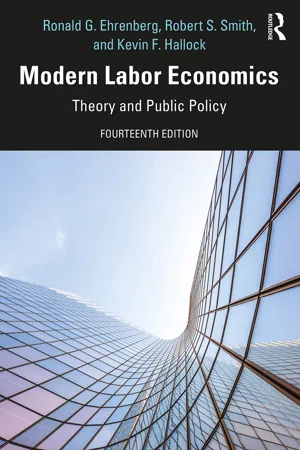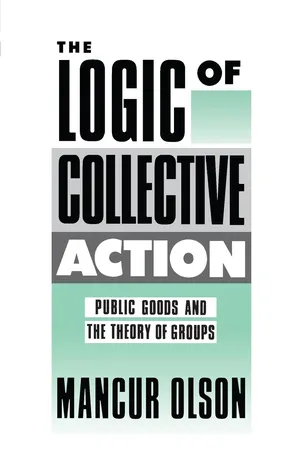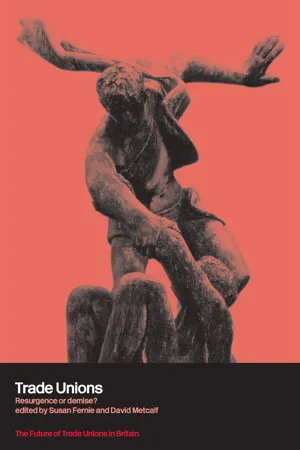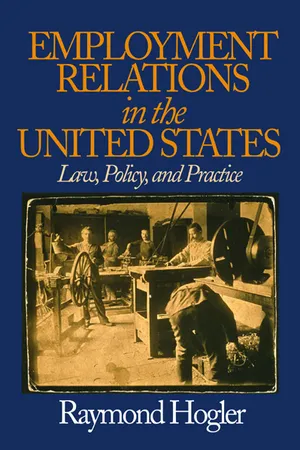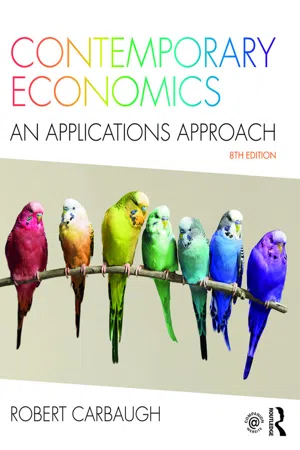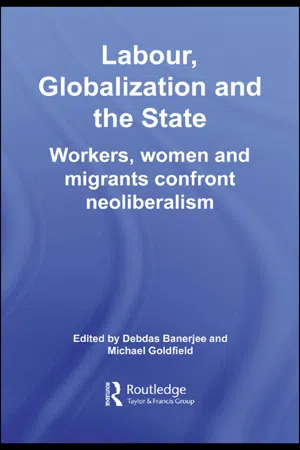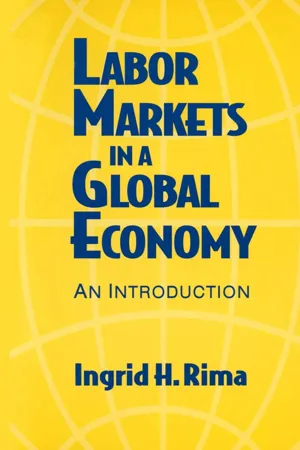Economics
Labor Unions in the US
Labor unions in the US are organizations formed by workers to protect their rights and negotiate with employers for better wages, benefits, and working conditions. They have played a significant role in shaping labor laws and regulations, and have been instrumental in advocating for workers' rights. While their influence has declined in recent decades, they continue to be a key force in the labor market.
Written by Perlego with AI-assistance
Related key terms
Related key terms
1 of 4
Related key terms
1 of 3
10 Key excerpts on "Labor Unions in the US"
- eBook - ePub
Modern Labor Economics
Theory and Public Policy
- Ronald Ehrenberg, Robert Smith, Kevin Hallock(Authors)
- 2021(Publication Date)
- Routledge(Publisher)
CHAPTER 13 Unions and the Labor MarketOur analysis of the workings of labor markets has, for the most part, omitted any mention of the role of labor unions and collective bargaining. Because many people have strong and conflicting opinions about the role of unions in U.S. society, remaining objective is often difficult when discussing them. Some people view labor unions as forms of monopolies that while benefiting their own members, impose substantial costs on other members of society. In contrast, others view unions as the major means by which workers have improved their economic status, as a counterbalance to corporations, and as important forces behind much social legislation.The purpose of this chapter is to analyze the goals, major activities, and overall effects of unions in the context of economic theory. We begin with some general descriptive material on unions internationally, adding a more comprehensive description of unions in the United States. Then we move to a fundamental theoretical question: What are the economic forces on the demand side of the market that constrain unions in their desire to improve the welfare of their members? With these constraints in mind, we devote the last half of the chapter to analyzing the primary activities of the collective bargaining process and to discussing empirical evidence on how unions affect wages, employment, labor productivity, and profits.Union Structure and Membership
Labor unions are organizations of workers whose primary objectives are to improve the pecuniary and nonpecuniary conditions of employment among their members. Unions can be classified into two types: An industrial union represents most of or all the workers in an industry or firm regardless of their occupations, and a craft - eBook - ePub
Understanding European Trade Unionism
Between Market, Class and Society
- Richard Hyman(Author)
- 2001(Publication Date)
- SAGE Publications Ltd(Publisher)
2
Trade Unions as Economic Actors
Regulating the Labour MarketIn most English-speaking countries, trade unions have traditionally been viewed as organizations the primary purpose of which is to secure economic benefits for their members; in particular, by advancing their ‘terms and conditions of employment’ through collective bargaining. From such a perspective, broader social and political objectives are of dubious legitimacy, or at best ancillary to unions’ economic functions.In this chapter I discuss the classic analysis of trade union functions presented by Sidney and Beatrice Webb over a century ago, and the doctrine of ‘business unionism’ which acquired particular force in the USA. In the latter model, industrial relations is perceived as a largely self-contained field of action. Unions succeed best, it is assumed, by their skill and determination in playing the labour market; other forms of union action do not facilitate, and may detract from, unions’ economic goals.Yet it is questionable how far the labour market can be treated as analogous to the general model of commodity markets; and likewise it is misleading to abstract market processes in general from the socio-political environment in which they are located. Accordingly, there is a contradiction at the heart of business unionism: trade unions can intervene effectively in regulating the labour market only to the extent that their aims and actions transcend the purely economic. - eBook - ePub
The Logic of Collective Action
Public Goods and the Theory of Groups, Second Printing with a New Preface and Appendix
- Mancur Olson Jr.(Author)
- 1971(Publication Date)
- Harvard University Press(Publisher)
large groups of workers.B. LABOR-UNION GROWTH IN THEORY AND PRACTICEThat labor unions are concerned about the “free rider” is well known. But this fact has not been given its due in the principal theories of the labor movement, and has been completely ignored in Selig Perlman’s well-known theory of the labor movement,27 one of the most impressive and outstanding theories of American labor unions. Perlman attempted to explain the growth of American labor unions, and their emphasis on collective bargaining rather than political reform, mainly through what he called “job consciousness.” This “job consciousness” is essentially a belief among workers that there is a scarcity of job opportunities, and this belief Perlman thought was due to a pervasive pessimism among manual workers.28 Perlman inferred this pessimism among manual workers from the rules and procedures they had developed in their unions. He noted that successful unions strive above all for “job control”—for devices to ensure that their own members will be the first hired and the last fired. The closed shop is viewed not so much as a device for strengthening the union as a technique designed to “conserve” scarce jobs for the workers in a given union.29 Restrictions on the employer’s freedom of dismissal are sought by the union, not so much for the protection of the organization as for apportioning the presumably scarce jobs among all of the members according to a “communism of opportunity.”30 - eBook - ePub
Trade Unions
Resurgence or Demise?
- Sue Fernie, David Metcalf(Authors)
- 2013(Publication Date)
- Routledge(Publisher)
From around 1870 and for most of the twentieth century, up to the Thatcher era, the share of labour in national income rose secularly, while that of capital gradually decayed correspondingly. Thus labour won the battle with capital, but without overturning capitalism. Given this switch in income shares away from profit towards pay most economists no longer pay much attention to the perceived inequality in bargaining power between capital and labour. So interest in this rationale for union activity has waned, and has been replaced by a new one which ‘shifts attention from imperfections in the structure of markets to imperfections in employment contracts and internal firm governance’ (Kaufman 2004b: 390). There are three main strands in this approach. First, unions replace individual voice with collective voice which enhances the supply of workplace public goods like safety or flexible working. Second, unions might boost productivity by lowering labour turnover, spoiling the quiet life of managers in monopolistic enterprises and ‘expanding the breadth and depth of employee involvement’. Third, unions lower transactions costs and increase efficiency by providing agency services to workers and firms. For workers, the union provides information (for example on wages in competing plants), monitors the performance of the employer and communicates workers’ preferences regarding personnel practices to the employer. The advantage of collective bargaining to the firm is that it signs one contract instead of hundreds of individual contracts (Freeman and Medoff 1984).Economists have historically paid great attention to the objectives and impact of trade unions. Often such work has influenced union prospects and the ebb and flow of membership. For example, in the USA research by the institutional economists contributed to the passing of the 1935 National Labor Relations Act which played a central role in restoring union fortunes over the next quarter of a century. And in the UK the work of Hayek (1980:58) and the Institute of Economic Affairs (1984) – ‘There can be no salvation for Britain until the special privileges granted to the trade unions three-quarters of a century ago are ended’ – provided the intellectual underpinning for the onslaught against unions by the Thatcher administration.In what follows we adopt a pragmatic and empirical economist approach to the analysis of British unions. In recent years there has been a great deal of careful economic research on the impact of unions on efficiency, equity and employee relations – the very items which so exercised the classical and neoclassical economists. These are analysed next. Economic techniques can also be applied to the work of industrial relations scholars to set out the costs and benefits of, for example, organizing and servicing (‘Hereafter: resurgence or perdition?’ section). It might be noted in passing that virtually every issue examined in this chapter was carefully analysed over a century ago by the Webbs in Industrial Democracy - eBook - ePub
Law and Economics
Alternative Economic Approaches to Legal and Regulatory Issues
- Margaret Oppenheimer, Nicholas Mercuro(Authors)
- 2015(Publication Date)
- Routledge(Publisher)
Part 4Legal Issues Concerning Labor, Employment, and Unemployment
9
An Alternative Economic Analysis of the Regulation of Unions and Collective Bargaining
Kenneth G. Dau-SchmidtSince the passage of the National Labor Relations Act (NLRA) in 1935, it has been the policy of American labor law to foster unionization and regulate collective bargaining for the purposes of promoting equity in bargaining power between employers and employees, and industrial peace.1 By protecting employee collective action, the framers of American labor law sought to allow employees to achieve some degree of parity with employers in the adjustment of disputes and the division of the proceeds of their labor. This system of “industrial democracy” was intended to provide employees with a greater say in the workplace and perhaps in society at large. Although strikes are a necessary evil in this process for the private resolution of grievances, the framers sought to minimize industrial strife by providing a system of elections to determine exclusive representatives, requiring “good faith” bargaining between unions and employers, and making collective bargaining agreements enforceable.This policy of fostering unions and regulating collective bargaining to promote equity and industrial peace makes no sense in the context of the traditional monopoly model of unions and collective bargaining. Under the monopoly model, unions cause inefficiency and inequity by establishing a labor cartel and prompting employers to cut production, inefficiently mix capital and labor, displace workers to unorganized markets, and raise prices to consumers.2 - eBook - ePub
Employment Relations in the United States
Law, Policy, and Practice
- Raymond L. (Louis) Hogler(Author)
- 2003(Publication Date)
- SAGE Publications, Inc(Publisher)
Higher wages might also be a factor contributing to inflation, which harms all consumers. Further, critics point out that unions stifle individual initiative by emphasizing collective action. Union security clauses, which require membership in a union as a condition of the job, clearly infringe upon the free choice of individual workers. From this perspective, such union characteristics are incompatible with the important social goals of human autonomy and liberty. Citizens of Oklahoma voted in September 2001 to prohibit compulsory union membership in that state, and the debates about the proposed law reflected the underlying concerns about freedom, economic prosperity, and communal values. 96 For such reasons, community attitudes toward workers’ collective activities are sometimes ambivalent. The stated purpose of the federal labor law is to “encourage the process of collective bargaining.” Assuming that goal remains viable, then the behavior of employers should be more effectively monitored to protect workers in their efforts to form unions. Conversely, as some scholars argue, perhaps unions should have no special legislative protections. At the end of the twentieth century, employees had an array of individual legal rights in the workplace. Those rights arguably supplant the need for group action. In any event, public policy choices must aim not only at economic ends but toward social considerations as well. By viewing the core of community as a collective endeavor based on obligation and responsibility, and not merely as a guarantor of economic freedom and a protector of property, we may appreciate the contributions of unions and their enhancement of democracy at the workplace. Bowling alone has its disadvantages. Summary The main ideas in this chapter are ones that carry on throughout the remainder of the book - No longer available |Learn more
Contemporary Economics
An Applications Approach
- Robert Carbaugh(Author)
- 2016(Publication Date)
- Routledge(Publisher)
3 At that time, the prevailing wage in manufacturing was only $2 to $3 per day. The offer to increase wages was motivated by the high rates of absenteeism and turnover that occurred among workers at Ford’s factories. Ford apparently hoped that an increase in wages would improve the morale of workers and encourage them to work harder in order to keep their high-paying jobs. As a result, Ford believed that labor productivity would increase. Immediately following the wage hike, more than 10,000 workers applied for employment with Ford. According to analysts, Ford’s tactic was successful. Employees remained on the job and worked harder, resulting in labor productivity gains exceeding 50 percent.3 Daniel Raff and Lawrence Summers, “Did Henry Ford Pay Efficiency Wages?” Journal of Labor Economics, October 1987, pp. 557–586.Are Workers Better Off With Labor Unions?
Throughout this chapter, we have assumed that individual workers actively compete in the sale of their services. In some markets, workers form unions in order to sell their services collectively. Unions exist because workers realize that acting together provides them with more bargaining power than they would have if they acted individually—putting them at the mercy of their employers. You are probably familiar with unions such as the United Auto Workers, the United Steel Workers, and the Teamsters.In 1970, about 25 percent of the U.S. labor force belonged to unions. Only about 12 percent are members today, as seen in Table 7.2 . With the declining role of manufacturing jobs in the workforce, continued union success hinges on penetrating the service sector. That’s very difficult to organize. Service workers tend to work in many different locations, and many jobs in the service sector are transient.The chief aim of a labor union is to improve the wages, hours, working conditions, and job security of its members. Unions act on behalf of workers to bargain with employers on matters relating to employment, a process known as collective bargaining. This process allows one negotiator to act as the workers’ agent rather than having each worker negotiate his own labor contract.Most disagreements between labor and management involve wages, hours, or other conditions of employment. If labor and management cannot settle their differences, they may receive outside help called mediation. If the two parties still cannot agree, they may submit to a process known as arbitration. A person called an arbitrator listens to both sides of a dispute and makes a decision that is binding on both sides. Strikes - eBook - ePub
Labor, Globalization and the State
Workers, Women and Migrants Confront Neoliberalism
- Debdas Banerjee, Michael Goldfield(Authors)
- 2007(Publication Date)
- Routledge(Publisher)
6 The impact of globalization and neoliberalism on the decline of organized labour in the United StatesMichael Goldfield1Labour movements in the economically developed capitalist countries are weaker today than they have been in decades. And, by a large variety of key quantitative and qualitative indicators US unions are undoubtedly the weakest of the lot, unable to defend the interests of American workers in the most basic of ways. Parallel to these developments are the accelerated pace of what is commonly referred to as ‘globalization’, the greater economic integration of large parts of the world, the more rapid movement of goods (trade), capital (investment) and sometimes labour (migration), both among the more economically developed countries (EDCs) and between these latter entities and the economically lesser developed countries (LDCs). Some have argued that globalization is an inaccurate term, since its defining characteristic is its neoliberal character. Some have also argued that this globalization is largely responsible for the weakening of labour movements in the so-called northern countries, especially the United States. This chapter will attempt to explore these questions, especially with respect to the United States. First, however, one must understand the contours of each phenomenon in greater detail, i.e. in their specificity.The decline of US organized labour
During the 1930s and 1940s, the US labour movement was as dynamic and militant as any in the world. In pitched battles against employers and the state, leaving hundreds, if not thousands, of working class martyrs, the unions organized millions of previously unorganized workers in basic industries (including auto, farm and construction equipment, steel, electrical, rubber, lumber, furniture, paper making, tobacco, clothing and apparel, shipping and longshore, trucking, coal and metal mining, oil production and refining, public transportation and a host of others). Along with other social movements during this period, they helped marginalize conservative politicians, making pro-business rhetoric by politicians’ political suicide. Perhaps indicative of this climate are the words of the then future president of the US Harry Truman (1945–52) in his first major Senate speech after his 1934 Senate election victory. Truman, it should be recalled was a moderate to conservative Democrat from Missouri, a southern border state, hardly the centre of home- grown US radicalism at the time: - eBook - ePub
What Do Unions Do?
A Twenty-year Perspective
- James T. Bennett, Bruce E. Kaufman(Authors)
- 2017(Publication Date)
- Routledge(Publisher)
Journal of Law and Economics 6 (October 1963): 69–78.——. The Economics of Trade Unions, 3rd ed. Chicago: University of Chicago Press, 1989.Reynolds, Lloyd and Cynthia Taft. The Evolution of Wage Structure. New Haven, Conn.: Yale University Press, 1956.Reynolds, Morgan. Power and Privilege: Labor Unions in America. New York: Universe Books, 1984.Ross, Arthur. Trade Union Wage Policy. Berkeley: University of California Press, 1948.Schwartz-Miller, Ann and Wayne Talley. “Technology and Labor Relations: Railroads and Ports.” Journal of Labor Research 23 (Fall 2002): 513–34.Shister, Joseph. “The Theory of Union Wage Rigidity.” Quarterly Journal of Economics 57 (August 1943): 522–42.Simon, Herbert. Models of Bounded Rationality, Vol. 2. Cambridge: MIT Press, 1982.Taras, Daphne and Allen Ponak. “Mandatory Agency Shop Laws As an Explanation of Canada-US Union Density Divergence.” In James Bennett and Bruce Kaufman, eds. The Future of Private Sector Unionism in the United States. Armonk, N. Y.: M. E. Sharpe, 2002, pp. 260–91.Ulman, Lloyd. “Marshall and Friedman on Union Strength.” Review of Economics and Statistics 37 (November 1955): 384–401.Vedder, Richard and Lowell Galloway. “The Economic Effects of Labor Unions Revisited.” Journal of Labor Research 23 (Winter 2002): 41–50.Vittoz, Victor. New Deal Labor Policy and the American Industrial Economy. Chapel Hill: University of North Carolina Press, 1987.Williamson, Oliver. The Economic Institutions of Capitalism. New York: Free Press, 1985.——, Michael Wachter, and J. Harris. “Understanding the Employment Relation: The Analysis of Idiosyncratic Exchange.” Bell Journal of Economics - eBook - ePub
Labor Markets in a Global Economy: A Macroeconomic Perspective
A Macroeconomic Perspective
- Ingrid H. Rima(Author)
- 2015(Publication Date)
- Routledge(Publisher)
Beginning with the original famous guarantee in the National Industrial Labor Relation Act of 1935 (Wagner Act) of the legal right of workers to unionize, and the requirement that employers bargain with union representatives, and culminating in the Fair Labor Standards Act of 1938, Congressional action addressed the objective of achieving a balance of power between employees and employers. Economists who concerned themselves with these “labor issues” often identified themselves with a distinctively American approach to the study of economics which became known as institutionalism. 3 World War II and the Changing Focus of Labor Economists The changes in the world of work that followed World War II and the prosperous 1950s and 1960s that followed diminished the economists’ interest in the union movement as a subject of academic interest. By the war’s end in 1945 unionized workers, though they amounted to only 28.9 percent of the workforce, had emerged as “big labor.” The general feeling that workers had demonstrated four years of patriotic wartime restraint made it possible for workers to be successful in pressing their wage demands. As workers flexed their collective muscles at the bargaining table, Congress eventually responded by passing the Taft-Hartley Act of 1947. This legislation restricted union behavior in ways that paralleled the restrictions that the Wagner Act had earlier imposed on employers. 4 These changes in the balance of power between workers and employers also encouraged the emergence of the field of “industrial relations,” which is now the focus of specialized courses in human resources management that flourish in business schools. After 1945, the postwar economy brought with it other institutional and societal changes that fundamentally altered labor-market behavior and, consequently, the ways in which economists defined the problems they would single out for study
Index pages curate the most relevant extracts from our library of academic textbooks. They’ve been created using an in-house natural language model (NLM), each adding context and meaning to key research topics.
Explore more topic indexes
Explore more topic indexes
1 of 6
Explore more topic indexes
1 of 4
